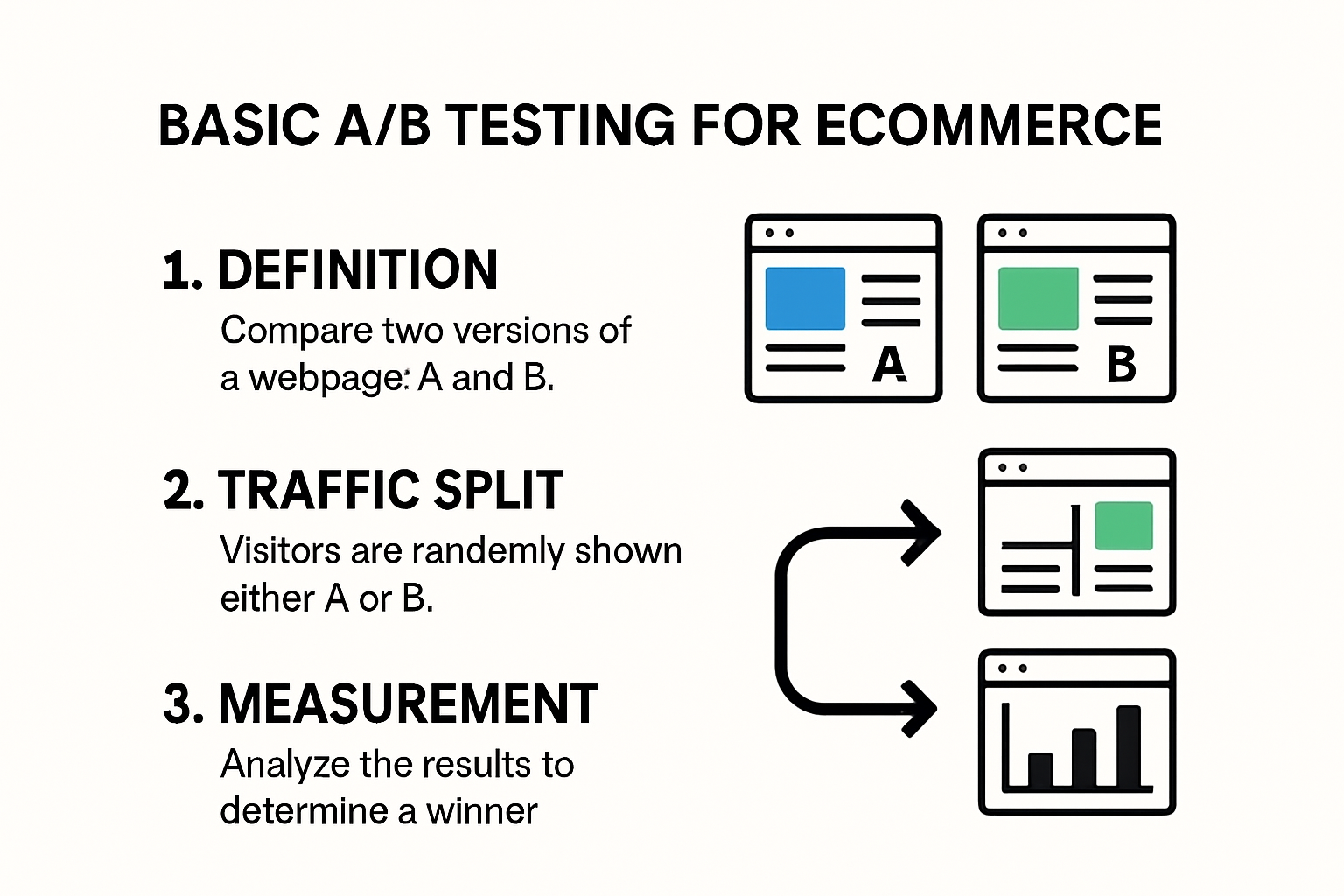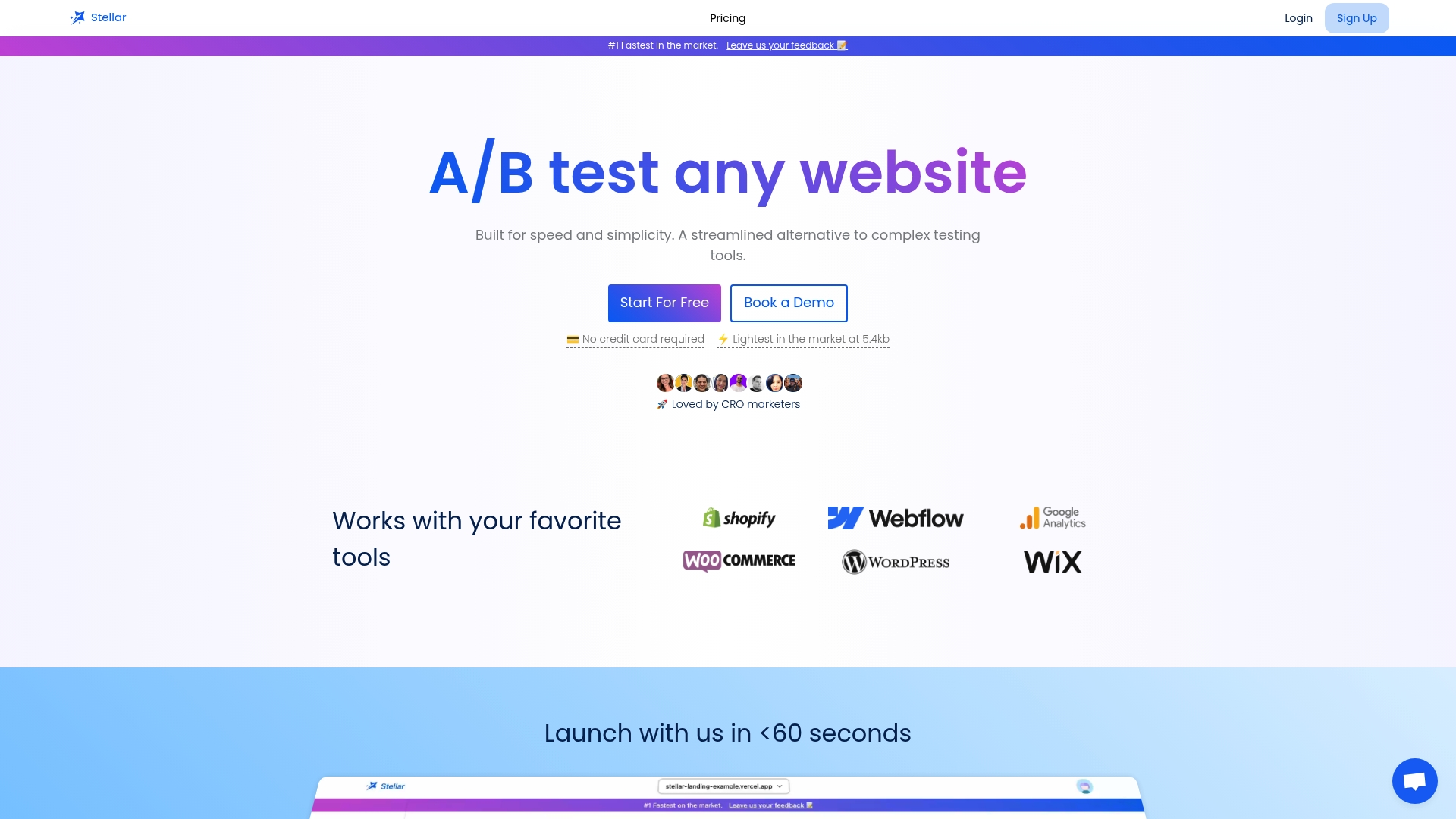
A/B Testing for Ecommerce: Strategies and Trends for 2025

Ecommerce sites tweak button colors and switch up layouts to squeeze every extra sale possible. Yet here’s a shocker. Just changing a checkout button’s color has lifted conversion rates by up to 15 percent in controlled experiments. Everyone talks about A/B testing as a basic tool, but the smartest brands now use AI to run thousands of experiments at once and predict shopper behavior before it happens. The old nostrums simply don’t cut it in 2025’s world of rapid-fire online competition.
Table of Contents
- Understanding The Core Principles Of A/B Testing
- Practical Steps To Set Up Ecommerce A/B Tests
- Key Elements To Test For Maximum Impact
- Trends And Best Practices For Ecommerce A/B Testing In 2025
Quick Summary
| Takeaway | Explanation |
|---|---|
| Define Clear Goals and Hypotheses | Establish specific, measurable objectives and testable hypotheses to guide A/B testing efforts effectively. |
| Optimize Critical Conversion Elements | Focus on testing key areas such as CTA buttons, product presentation, and checkout processes to enhance user engagement and conversion rates. |
| Utilize Data-Driven Statistical Analysis | Ensure robust statistical validation by calculating p-values and confidence intervals to derive actionable insights from A/B test results. |
| Embrace Emerging Technologies | Incorporate AI and machine learning to enhance testing methodologies, enabling predictive analysis and real-time optimization of experimental designs. |
| Prioritize Ethical Considerations | Maintain user trust by implementing transparent practices and ensuring data privacy compliance during A/B testing experiments. |
Understanding the Core Principles of A/B Testing
A/B testing represents a powerful methodological approach that enables businesses to make data-driven decisions through systematic experimentation. At its core, this technique involves comparing two variants to determine which performs more effectively in achieving specific objectives.
The Scientific Foundation of A/B Testing
A/B testing emerges from rigorous scientific principles of controlled experimentation. Research from ScienceDirect reveals that online controlled experimentation allows organizations to compare different software feature variants from an end user's perspective. This method transforms subjective decision-making into an objective, quantitative process.
The fundamental mechanism involves presenting two versions (A and B) of a webpage, app interface, or marketing element to different user segments simultaneously. By tracking user interactions, businesses can statistically determine which version generates superior outcomes. This approach minimizes guesswork and provides concrete insights into user preferences and behaviors.

Key Components and Experimental Design
Successful A/B testing requires meticulous planning and execution. According to experimental research, the process involves multiple critical roles: concept designers, experiment architects, setup technicians, experiment coordinators, and assessors. Each professional contributes unique expertise to ensure rigorous and reliable results.
The primary targets of A/B testing in e-commerce typically include:
- Algorithmic Optimization: Refining recommendation engines and personalization mechanisms
- Visual Element Testing: Evaluating design variations, color schemes, and layout configurations
- Workflow Improvements: Analyzing user journey effectiveness and conversion path efficiency
Statistical Significance and Interpretation
Interpreting A/B test results demands sophisticated statistical analysis. Researchers must establish statistical significance, which determines whether observed differences are genuine or merely coincidental. This involves calculating p-values, confidence intervals, and understanding type I and type II errors.
Businesses must also consider sample size, testing duration, and potential external variables that might influence results. A hasty or poorly designed experiment can lead to misleading conclusions that could negatively impact strategic decisions.
Explore our comprehensive guide on advanced A/B testing strategies to develop a nuanced understanding of these sophisticated experimental techniques. The landscape of digital experimentation continues to evolve, offering increasingly sophisticated methods for understanding user behavior and optimizing digital experiences.
To provide a clearer overview of the roles and key focus areas in e-commerce A/B testing, see the following summary table:
| Role | Description | Typical Focus |
|---|---|---|
| Concept Designer | Develops testing concepts and ideas | New features or design variations |
| Experiment Architect | Designs the structure and variables of the experiment | Experiment design & hypothesis |
| Setup Technician | Implements technical aspects and deploys variants | Technical deployment |
| Experiment Coordinator | Monitors test execution and ensures process adherence | Oversight & process management |
| Assessor | Analyzes and interprets test data and outcomes | Data analysis & insights |
Practical Steps to Set Up Ecommerce A/B Tests
Successful A/B testing in e-commerce requires a structured and strategic approach that transforms data into actionable insights. The process demands precision, careful planning, and a comprehensive understanding of experimental design.
Defining Clear Goals and Hypotheses
Research from growth-onomics.com emphasizes the critical importance of establishing clear objectives before launching any A/B test. Effective goal setting involves identifying specific, measurable outcomes such as conversion rates, average order value, or user engagement metrics.
Crafting a robust hypothesis requires more than intuition. Businesses must develop testable statements that predict the potential impact of proposed changes. For instance, a hypothesis might state: "Changing the product page checkout button color from blue to green will increase conversion rates by 15%." This approach transforms subjective design choices into quantifiable experiments.
Experimental Design and Traffic Allocation
According to experimental research, the A/B testing process involves several critical steps:
- Variation Creation: Develop two distinct versions of the element being tested
- Randomized Segmentation: Divide website traffic equally between variants
- Controlled Environment: Ensure all other factors remain consistent
Timing plays a crucial role in obtaining reliable results. Growth experts recommend running tests for at least two full business cycles, typically spanning two to four weeks. This duration accounts for variations in traffic patterns and ensures capturing comprehensive user behavior data.
Data Collection and Statistical Validation
Interpreting test results requires sophisticated statistical analysis. Experimental research highlights the importance of random user assignment to minimize bias and ensure statistically significant outcomes.
Key considerations include:
- Calculating confidence intervals
- Determining statistical significance
- Identifying potential external variables
- Understanding margin of error
Discover advanced A/B testing strategies for e-commerce to refine your experimental approach. The most successful businesses treat A/B testing as an ongoing process of continuous optimization, using each experiment to gain deeper insights into user preferences and behavior.
For an at-a-glance breakdown of the essential steps in setting up an e-commerce A/B test, reference the table below:
| Step | Description |
|---|---|
| Define Goals | Determine the specific, measurable objectives to target |
| Craft Hypothesis | Develop a testable prediction based on expected outcomes |
| Create Variations | Design different versions of web elements/features |
| Allocate Traffic | Randomly assign users equally to each variation |
| Implement Controls | Keep all other factors constant to reduce bias |
| Run Test (Timing) | Operate tests for 2-4 weeks or 2 business cycles |
| Analyze Data | Use statistical methods to validate differences |
| Interpret Results | Derive actionable insights for optimization decisions |
Key Elements to Test for Maximum Impact
Maximizing e-commerce performance requires strategic testing of critical website elements that directly influence user experience and conversion rates. Understanding which components to optimize can transform visitor interactions into tangible business outcomes.
Critical Conversion Elements
Research from Ironplane reveals several high-impact areas for A/B testing in e-commerce. Call-to-action (CTA) buttons represent a prime testing ground, where subtle variations can yield significant results.
Key CTA testing parameters include:
- Button Text: Comparing phrases like "Buy Now" versus "Add to Cart"
- Color Variations: Evaluating how different color schemes influence click-through rates
- Placement and Size: Determining optimal visual positioning and dimensional attributes
Product presentation also plays a crucial role. Experimenting with image configurations, description formats, and visual storytelling can dramatically enhance user engagement. Businesses should consider testing multiple image angles, zoom capabilities, and contextual product representations to understand what resonates most with their target audience.
Checkout Process Optimization
The checkout experience represents a critical conversion funnel where minor friction can lead to substantial revenue loss. E-commerce optimization experts recommend comprehensive testing of checkout workflow elements.
Potential optimization areas include:
- Reducing form field complexity
- Offering guest checkout options
- Implementing progressive disclosure techniques
- Displaying security indicators prominently
- Streamlining payment method selections
By systematically reducing cognitive load and perceived transactional risk, businesses can significantly improve conversion rates and minimize cart abandonment.

Advanced Personalization Strategies
Beyond traditional elements, cutting-edge A/B testing explores nuanced personalization techniques. Dynamic content adaptation based on user segments, real-time behavioral triggers, and contextual recommendations represent sophisticated optimization approaches.
Consider testing:
- Personalized product recommendations
- Location-based pricing strategies
- User-specific promotional content
- Adaptive navigation experiences
Explore advanced A/B testing methodologies to unlock deeper insights into user behavior and preferences. Successful e-commerce platforms recognize that continuous experimentation is not just a technique but a fundamental business strategy for staying competitive in an increasingly dynamic digital marketplace.
Trends and Best Practices for Ecommerce A/B Testing in 2025
As e-commerce continues to evolve, A/B testing strategies must adapt to increasingly sophisticated user expectations and technological capabilities. The landscape of digital experimentation demands a nuanced approach that balances technological innovation with user-centric design principles.
Emerging Technological Innovations
The integration of artificial intelligence and machine learning is transforming A/B testing methodologies. Advanced algorithms now enable more precise segmentation, predictive analysis, and real-time optimization of testing parameters. Businesses can leverage these technologies to create more targeted and dynamic experimental designs.
Key technological trends include:
- Automated Variation Generation: AI-powered tools that automatically create and test multiple design variations
- Predictive User Behavior Modeling: Machine learning algorithms that anticipate user responses before extensive testing
- Cross-Platform Experimentation: Unified testing frameworks that work seamlessly across multiple digital touchpoints
Holistic Experimentation Strategies
Successful A/B testing in 2025 requires a more comprehensive approach that goes beyond simple binary comparisons. Conversion optimization experts recommend developing multi-dimensional testing strategies that consider broader user experience contexts.
Comprehensive testing approaches should focus on:
- Integrating qualitative and quantitative data
- Considering long-term user lifetime value
- Developing more nuanced segmentation strategies
- Understanding contextual variations in user behavior
Ethical Considerations and User Privacy
With increasing concerns about data privacy, A/B testing must prioritize transparent and ethical experimentation practices. Businesses need to balance their optimization efforts with respect for user consent and data protection regulations.
Critical ethical considerations include:
- Obtaining clear user consent for experimental tracking
- Implementing robust data anonymization techniques
- Ensuring minimal disruption to user experience
- Maintaining transparency about testing processes
Discover cutting-edge A/B testing strategies that push the boundaries of digital experimentation while maintaining user trust. The most successful e-commerce platforms will be those that can seamlessly integrate advanced technological capabilities with a deep understanding of user needs and ethical considerations.
As we move further into 2025, A/B testing will continue to evolve from a simple optimization technique to a sophisticated approach of understanding and anticipating user behavior. Businesses that embrace these emerging trends will gain a significant competitive advantage in the rapidly changing digital marketplace.
Frequently Asked Questions
What is A/B testing in ecommerce?
A/B testing in ecommerce is a method of comparing two versions of a webpage, app interface, or marketing element to determine which one performs better in achieving specific business goals, such as increasing conversion rates.
How can I set clear goals for my A/B tests?
To set clear goals for your A/B tests, identify specific, measurable outcomes like conversion rates or average order value. Craft a testable hypothesis that predicts the impact of changes, ensuring your objectives guide the testing process effectively.
What elements should I focus on testing for maximum impact?
Focus on testing critical conversion elements such as call-to-action (CTA) buttons, product presentations, and the checkout process. Optimizing these areas can significantly enhance user engagement and conversion rates.
How does emerging technology influence A/B testing in 2025?
Emerging technologies like artificial intelligence and machine learning enable more precise segmentation, predictive analysis, and real-time optimization of tests. These innovations allow businesses to automate variation generation and enhance their A/B testing strategies.
Move Beyond Guesswork: Accelerate Ecommerce Growth With Effortless A/B Testing
You read how advanced A/B testing now separates average ecommerce brands from top performers. But implementing these sophisticated strategies can slow you down. Marketers and product managers often struggle with clunky tools, technical barriers, and the risk of hurting website performance. Users in 2025 need intuitive solutions that work as fast as they do, with real-time insights and minimal resource drain.

Ready to turn ideas from the A/B Testing for Ecommerce: Strategies and Trends for 2025 article into real results? Stellar offers streamlined A/B testing designed to boost conversions without complexity. Try our no-code visual editor for fast experiments and see performance lift with a script that is lighter than almost any competitor. Get started today, explore the Stellar platform, and experience the quickest way to actionable optimization.
Recommended
- Best A/B Test Ideas for Marketers in 2025
- Conversion Rate Optimization Strategies for Marketers in 2025
- Ecommerce Conversion Rate Optimization Strategies for 2025
- Landing Page A/B Testing Strategies for Marketers in 2025
- Shopify AB Testing: Boost Sales with Proven Strategies (2025)
- SEO AB Test Strategies for CRO Marketers in 2025
Published: 7/8/2025
